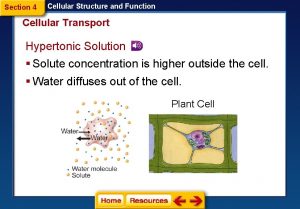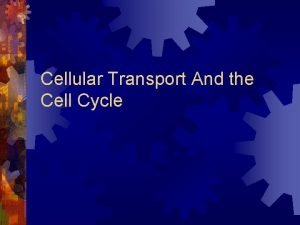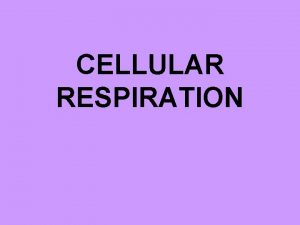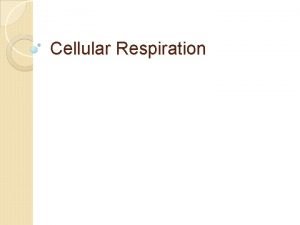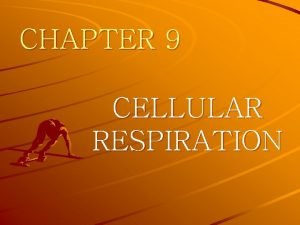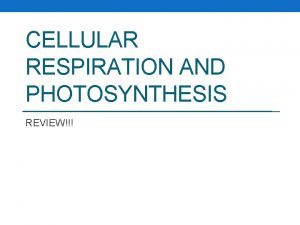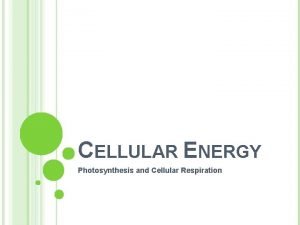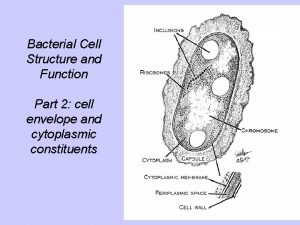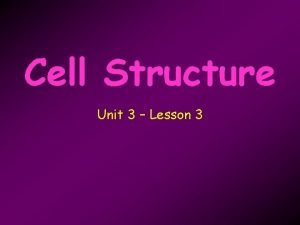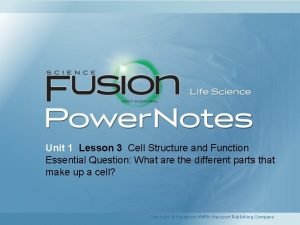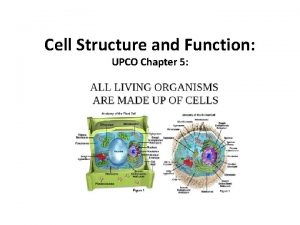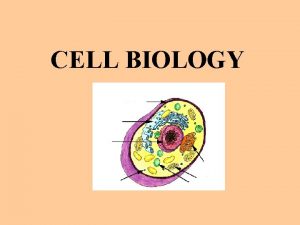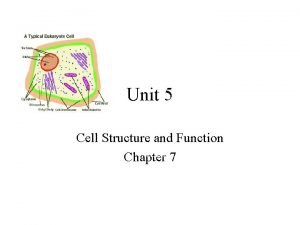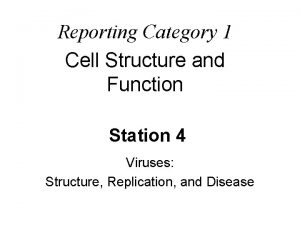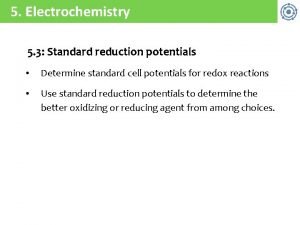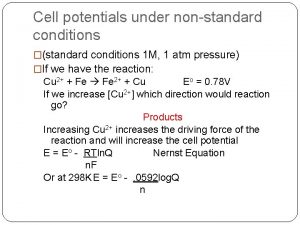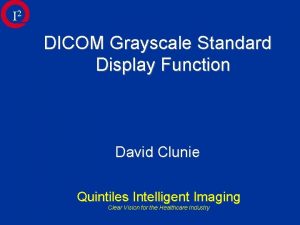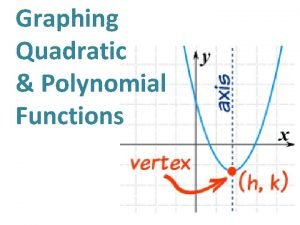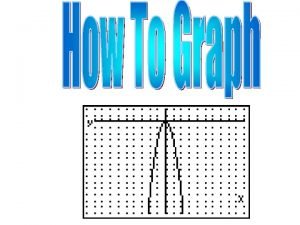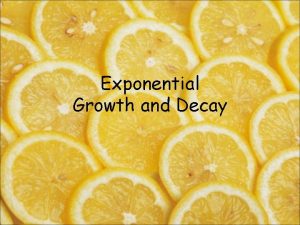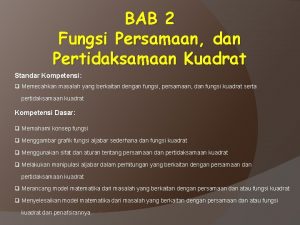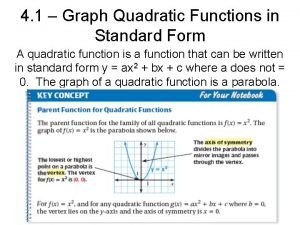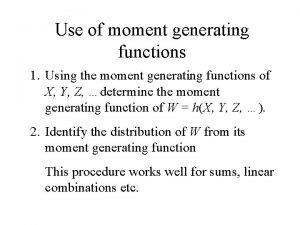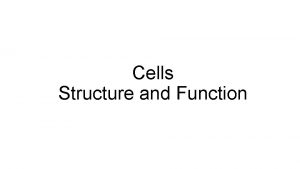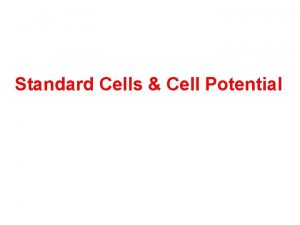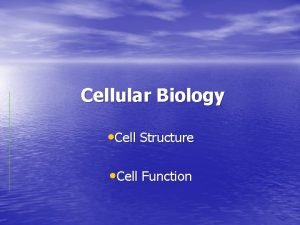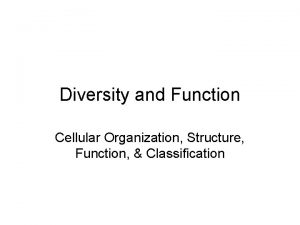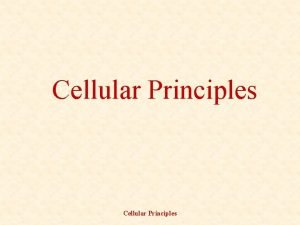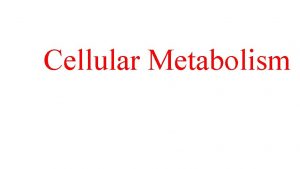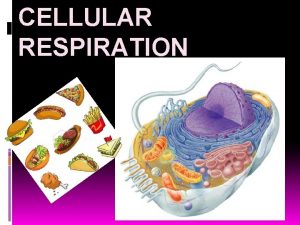Cell Structure Function Standard 2 Cellular Structure Cell















































- Slides: 47

Cell Structure & Function Standard 2: Cellular Structure

Cell Theory 1. All living things are made up of cells. 2. Cells are the smallest working units of all living things. 3. All cells come from pre-existing cells through cell division.

Definition of Cell • A cell is the smallest unit that is capable of performing life functions. • A cell is the basic unit of life.

Who Discovered the cell? • Robert Hooke – The first person to see cells, he was looking at cork and noted that he saw "a great many boxes. ” (1665)

Who Discovered Cells? • Anton van Leeuwenhock – Observed living cells in pond water, which he called "animalcules" (1673)

Examples of Cells Amoeba Proteus Plant Stem Bacteria Red Blood Cell Nerve Cell

Two Types of Cells • Prokaryotic- primitive, disorganized • Eukaryotic- organized, complicated

Prokaryotic • Do not have structures surrounded by membranes • Few internal structures • One-celled organisms, Bacteria http: //library. thinkquest. org/C 004535/prokaryotic_cells. html

Eukaryotic • Contain organelles surrounded by membranes • Most living organisms Plant http: //library. thinkquest. org/C 004535/eukaryotic_cells. html Animal

“Typical” Animal Cell http: //web. jjay. cuny. edu/~acarpi/NSC/images/cell. gif

“Typical” Plant Cell http: //waynesword. palomar. edu/images/plant 3. gif

Animal vs Plant Cells • ONLY in plant cells: – Chloroplasts- organelle in which photosynthesis occurs – Cell Wall- protects the plant cell and maintains its shape – 1 LARGE Vacuole: used for storage

Cell Parts Organelles

Cell Membrane • Outer membrane of cell that controls movement in and out of the cell • Double layer • Phospholipid bilayer http: //library. thinkquest. org/12413/structures. html

Cell Membrane • Plasma membrane– Regulates the transport of substances across the boundary. – Fluid-like • Composed of mostly proteins and a type of lipid called a phospholipid.

Cell Membrane • Phospholipid Molecule 1. two fatty acids (the tail) 2. Phosphate group (the head)

Cell Membrane • Phospholipid Bilayer– Two-layer “sandwich” of molecules that surrounds a cell.

Cell Membrane • Proteins in the phospholipid bilayer – Enzymes activity – Cell-to-cell recognition – Cell signaling – Transport of materials

Cell Wall • Most commonly found in plant cells • Supports & protects cell • Made of cellulose http: //library. thinkquest. org/12413/structures. html

Nucleus • Controls cell activities- brain of the cell • Separated from cytoplasm by nuclear membrane • Contains genetic material - DNA

Nuclear Membrane • Surrounds nucleus • Made of two layers • Openings allow material to enter and leave nucleus (RNA) http: //library. thinkquest. org/12413/structures. html

Chromosomes • Found in nucleus • Made of DNA • Contain instructions for traits & characteristics (blueprint) http: //library. thinkquest. org/12413/structures. html

Nucleolus • Inside nucleus • Contains RNA to build proteins http: //library. thinkquest. org/12413/structures. html

Cytoplasm • Gel-like mixture • Surrounded by cell membrane • Found in-between each organelle

Endoplasmic Reticulum • Moves materials around in cell • Smooth ER: lacks ribosomes (lipid production) • Rough ER (pictured): ribosomes embedded in surface (contain ribosomes) http: //library. thinkquest. org/12413/structures. html

Ribosomes • Each cell contains thousands • Make proteins • Found on ribosomes & floating throughout the cell http: //library. thinkquest. org/12413/structures. html

Mitochondria • POWERHOUSE of the cell • Produces energy through chemical reactions – breaking down fats & carbohydrates • Controls level of water and other materials in cell • Recycles and decomposes proteins, fats, and carbohydrates http: //library. thinkquest. org/12413/structures. html

Golgi Bodies • Protein 'packaging plant' • Move materials within the cell • Move materials out of the cell http: //library. thinkquest. org/12413/structures. html

Lysosome • Digestion – Breaks down proteins, fats, and carbohydrates • Transports and breaks down undigested material to cell membrane for removal • Cell breaks down if lysosome explodes http: //library. thinkquest. org/12413/structures. html

Vacuoles • Membrane-bound sacs for storage, digestion, and waste removal • Contains water solution • Help plants maintain shape (1 large vacuole) http: //library. thinkquest. org/12413/structures. html

Chloroplast • Found in plant cells • Contains green chlorophyll • Where photosynthesis takes place http: //library. thinkquest. org/12413/structures. html

Peroxisomes • Abundant in liver and kidney cells • Catalyze a variety of biochemical reactions: – Synthesis of bile acids (used to digest fats) – Detoxification of hydrogen peroxide – Break down of certain lipids – Detoxifies alcohol

Vesicle • Small membrane sacs that specialize in moving products into, out of, and within the cell. – Two Processes • 1. Exocytosis-Export of materials • 2. Endocytosis- Import of materials

How do cells move? • Cilia – Shorter and more numerous than flagella. Used for locomotion • Flagella – Long, whip-like structures, with a core of microtubules. Helps propel cells.

How does something pass through the membrane? • Active Transport – ENERGY required! • Passive Transport – NO energy required! – Selective (Semi) permeable membraneallows some substances to cross more easily than others.

Passive Transport • NO energy required! – 1. Diffusion- The net movement of particles of a substance from high concentration to low concentration. • Equilibrium- number of molecules moving in one direction is equal to the number of molecules moving in the other direction.

Passive Transport • NO energy required! – 2. Facilitative Diffusion- transport proteins provide a pathway for certain molecules to pass. • Facilitate means “to help”

Passive Transport • NO energy required! – 3. Osmosis- passive transport of water across a selective permeable membrane. • Hypertonic- higher concentration of solute • Hypotonic- Lower concentration of solute • Isotonic- concentrations of solute are equal

Passive Transport

Passive Transport • Passive Transport

Active Transport • Active Transport – Cell uses energy (ATP) to move molecules or ions across a cell membrane • Pumps in the opposite direction of diffusion (low concentration to high concentration)

Active Transport • 1. Endocytosis 1. Pinocytosis » membrane take in tiny droplets of liquid from their surroundings » Beneficial because the cell can take in water and particles that dissolve in it. 2. Phagocytosis » Membrane engulfs particles from its surroundings

Active Transport • 1. Endocytosis (continued) 3. Vesicle: made of phospholipids

Active Transport • 2. Exocytosis – Reverse of endocytosis. • Vesicles fuse to membrane to get particles OUT of the cell

Active Transport • Na+/K+ pump-Occurs in Nerve cells • Animal cell contains a higher concentration of potassium ions (K+) and a lower concentration of Sodium ions (Na+) in its fluid surroundings.

The Microscope • Types of microscopes – 1. Light Microscopes • Scientists use stains or dyes to show the different structures inside a cell • You are probably most familiar with a compound like microscope

The Microscope • Types of Microscopes – 2. Electron Microscope • Used to study very small things…. shows things are 1 billionth of a meter in size. – Example: DNA
 Section 4 cellular transport answer key
Section 4 cellular transport answer key Cellular transport and the cell cycle
Cellular transport and the cell cycle All cells must contain
All cells must contain Where in the cell does cellular respiration occur
Where in the cell does cellular respiration occur Where in the cell does cellular respiration occur
Where in the cell does cellular respiration occur Cell wall function
Cell wall function What are the reactants and products of photosynthesis
What are the reactants and products of photosynthesis Function of cellular respiration
Function of cellular respiration Cellular respiration equation
Cellular respiration equation What is part 2
What is part 2 Lesson 3 cell structure and function answer key
Lesson 3 cell structure and function answer key Cell organelles structures and functions organizer
Cell organelles structures and functions organizer Cell structure of a plant
Cell structure of a plant Cell
Cell Biology chapter 7 cell structure and function
Biology chapter 7 cell structure and function Chapter 7 cell structure and function section review 7-2
Chapter 7 cell structure and function section review 7-2 Organelle
Organelle Chapter 5 cell structure and function
Chapter 5 cell structure and function Cell structure and function
Cell structure and function Unit 5 cell structure and function answer key
Unit 5 cell structure and function answer key Category 1 cell structure and function
Category 1 cell structure and function Category 1 cell structure and function
Category 1 cell structure and function Category 1 cell structure and function
Category 1 cell structure and function Estimated standard error of mean
Estimated standard error of mean Standard language meaning
Standard language meaning Difference between actual cost and standard cost
Difference between actual cost and standard cost Standard kandungan dan standard pembelajaran
Standard kandungan dan standard pembelajaran Standard cell potentials
Standard cell potentials How to find cell potential under nonstandard conditions
How to find cell potential under nonstandard conditions Dicom monitor standard
Dicom monitor standard Graph functions
Graph functions Quadratic function
Quadratic function General form to standard form quadratic
General form to standard form quadratic How to reduce rational numbers to standard form
How to reduce rational numbers to standard form Standard form of exponential function
Standard form of exponential function Equation in standard form
Equation in standard form Persamaan dan pertidaksamaan kuadrat
Persamaan dan pertidaksamaan kuadrat Graph quadratic functions in standard form
Graph quadratic functions in standard form Mgf of normal distribution
Mgf of normal distribution Grayscale standard display function
Grayscale standard display function Cell city analogy project
Cell city analogy project Difference between mercury cell and diaphragm cell
Difference between mercury cell and diaphragm cell Prokaryotic vs eukaryotic cell
Prokaryotic vs eukaryotic cell Prokaryotic cell and eukaryotic cell similarities
Prokaryotic cell and eukaryotic cell similarities Animal and plant cell venn diagram
Animal and plant cell venn diagram S
S Dry cell vs wet cell
Dry cell vs wet cell Comparing plant and animal cells venn diagram
Comparing plant and animal cells venn diagram
